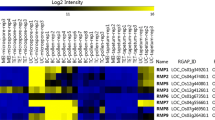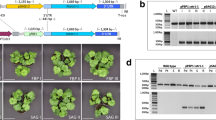Summary
The cauliflower mosaic virus 35S (35S-CaMV) promoter, which is generally used as a constitutive promoter in plants, is known to be silent during microspore and pollen development. Here we analyzed whether the 35S-CaMV promoter fused to thegus (β-glucuronidase) gene can be used as a marker for early sporophytic development in embryogenic microspore cultures of tobacco andBrassica napus. In microspore culture ofB. napus, the 35S-CaMV promoter remained off from the start of embryogenic culture up to the mid-cotyledonary embryo stage. 35S-CaMV promoter activity was only present in those microspores that initiated sporophytic development, but failed to enter embryogenic development. Similar results were also obtained with shed-microspore cultures of tobacco, in which rapid, direct embryogenesis takes place. In isolated-microspore cultures, in which embryogenesis is delayed, an intermitting period of sporophytic development was observed, characterized by extensive 35S-CaMV promoter activity. Therefore, the 35S-CaMV promoter discriminates between two classes of sporophytic development: it is activated in microspores which change fate from gametophytic into (temporarily) nonembryogenic sporophytic development, whereas the promoter is silent in sporophytic microspores that enter embryogenic development directly. This mirrors our observation that the 35S-CaMV promoter is also silent in young zygotic embryos.
Similar content being viewed by others
References
Benfey PN, Chua NH (1989) The cauliflower mosaic virus 35S-CaMV promoter: combinatorial regulation of transcription in plants. Science 250: 959–966
Cordewener JHG, Custers JBM, Dons HJM, van Lockeren Campagne MM (1996) Molecular and biochemical events during the induction of microspore embryogenesis. In: Jain SM, Sopory SK, Veilleux RE (eds) In vitro haploid production in higher plants, vol 1. Kluwer, Dordrecht, pp 111–124
Custers JBM, Cordewener JHG, Nöllen Y, Dons HJM, van Lookeren Campagne MM (1994) Temperature controls both gametophytic and sporophytic development in microspore cultures ofBrassica napus. Plant Cell Rep 13: 267–271
— —, Dons HJM, van Lookeren Campagne MM (1996) Regulation of the inductive phase of microspore embryogenesis inBrassica napus. Acta Hort 407: 209–217
—, Oldenhof MT, Schrauwen JAM, Cordewener JHG, Wullems GJ, van Lookeren Campagne MM (1997) Analysis of microspore-specific promoters in transgenic tobacco. Plant Mol Biol 35: 689–699
De Block M, de Brouwer D, Tenning P (1989) Transformation ofBrassica napus andBrassica oleracea usingAgrobacterium tumefaciens and the expression of thebar andneo genes in transgenic plants. Plant Physiol 91: 694–701
Ellis DD, McCabe D, Russell D, Martinell B, McCown BH (1991) Expression of inducible angiosperm promoters in a gymnosperm,Picea glauca (white spruce). Plant Mol Biol 17: 19–27
Ferrie AMR, Palmer CE, Keller WA (1994) Biotechnological applications of haploids. In: Shargool PD, Ngo TT (eds) Biotechnological applications of plant cultures. CRC Press, Boca Raton, pp 77–110
Horsch RB, Fry JE, Hoffmann NL, Eichholtz D, Rogers SG, Fraley RT (1985) A simple and general method for transferring genes into plants. Science 227: 1229–1231
Hunold R, Burrus M, Bronner R, Duret JP, Hahne G (1995) Transient gene expression in sunflower (Helianthusannuus L.) following microprojectile bombardement. Plant Sci 105: 95–109
Khush GS, Virmani SS (1996) Haploids in plant breeding. In: Jain SM, Sopory SK, Veilleux RE (eds) In vitro haploid production in higher plants, vol 1. Kluwer, Dordrecht, pp 11–33
Kyo M, Harada H (1986) Control of the developmental pathway of tobacco pollen in vitro. Planta 168: 427–432
Loeb TA, Reynolds TL (1994) Transient expression of theuidA gene in pollen embryoids of wheat following microprojectile bombardement. Plant Sci 104: 81–91
Mascarenhas JP, Hamilton DA (1992) Artifacts in the localization of GUS activity in anthers of petunia transformed with a CaMV 35S-GUS construct. Plant J 3: 405–408
Moore PJ, Moore AJ, Collins GB (1994) Genotypic and developmental regulation of transient expression of a reporter gene in soybean zygotic cotyledons. Plant Cell Rep 13: 556–560
Morrison RA, Evans DA, Fan Z (1991) Haploid plants from tissue culture: application in crop improvement. In: Biswas BB, Harris JR (eds) Subcellular biochemistry, vol 17, plant genetic engineering. Plenum, New York, pp 53–72
Murashige T, Skoog F (1962) A revised medium for rapid growth and bioassays with tobacco tissue cultures. Physiol Plant 15: 473–479
Odell JT, Hoopes JL, Vermerris W (1994) Seed-specific gene activation mediated by the Cre/lox site-specific recombination system. Plant Physiol 106: 447–458
Reinert J, Bajaj YPS, Heberle E (1975) Induction of haploid tobacco plants from isolated pollen. Protoplasma 84: 191–196
Shepherd RJ (1981) Cauliflower mosaic virus. Holywell Press, Oxford (CMI/AAB description of plant viruses, no 243)
Stöger E, Benito Moreno RM, Ylstra B, Vicente O, Heberle-Bors E (1992) Comparison of different techniques for gene transfer into mature and immature tobacco pollen. Transgenic Res 1: 71–78
Töpfer R, Matzeit V, Gronenborn B, Schell J, Steinbiss HH (1987) A set of plant expression vectors for transcriptional and translational fusions. Nucleic Acids Res 15: 5990
Touraev A, Ilham A, Vicente O, Heberle-Bors E (1996) Stress-induced microspore embryogenesis in tobacco: an optimized system for molecular studies. Plant Cell Rep 15: 561–565
—, Vicente O, Heberle-Bors E (1997) Initiation of microspore embryogenesis by stress. Trends Plant Sci 2: 297–302
Twell D, Klein TM, Fromm ME, McCormick (1989) Transient expression of chimeric genes delivered into pollen by microprojectile bombardement. Plant Physiol 91: 1270–1274
Uwer U, Wilmitzer L, Altmann T (1998) Inactivation of a glycyl-tRNA synthetase leads to an arrest in plant embryo development. Plant Cell 10: 1277–1294
Vancanneyt G, Schmidt R, O'Conner-Sanchez A, Willmitzer L, Rocha-Sosa M (1990) Construction of an intron-containing marker gene: splicing of the intron in transgenic plants and its use in monitoring early events inAgrobacterium-mediated plant transformation. Mol Gen Genet 220: 245–250
Wilkinson JE, Twell D, Lindsey K (1997) Activities of CaMV 35S and nos promoters in pollen: implications for field release of transgenic plants. J Exp Bot 48: 265–275
Author information
Authors and Affiliations
Corresponding author
Rights and permissions
About this article
Cite this article
Custers, J.B.M., Snepvangers, S.C.H.J., Jansen, H.J. et al. The 35S-CaMV promoter is silent during early embryogenesis but activated during nonembryogenic sporophytic development in microspore culture. Protoplasma 208, 257–264 (1999). https://doi.org/10.1007/BF01279097
Received:
Accepted:
Issue Date:
DOI: https://doi.org/10.1007/BF01279097




